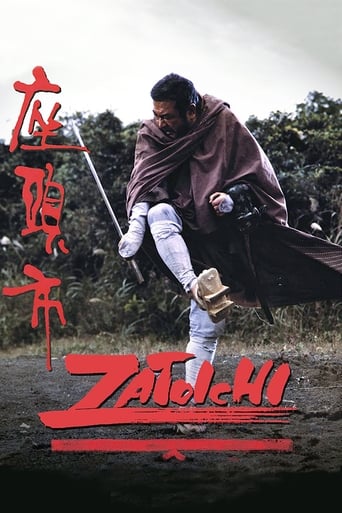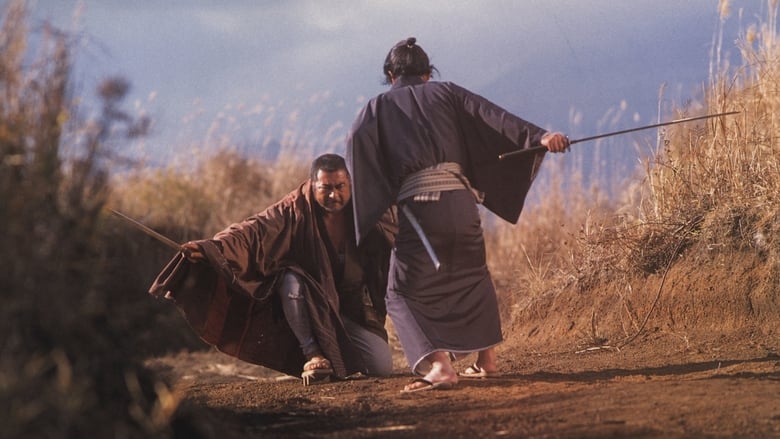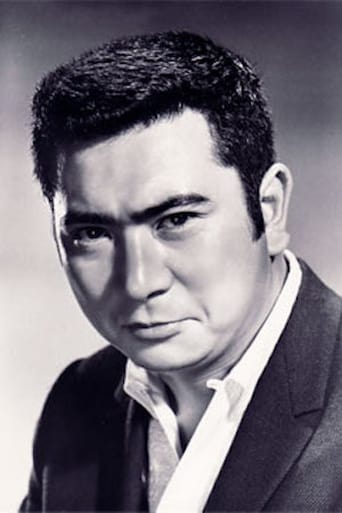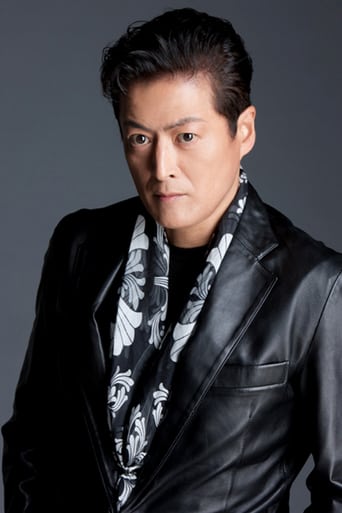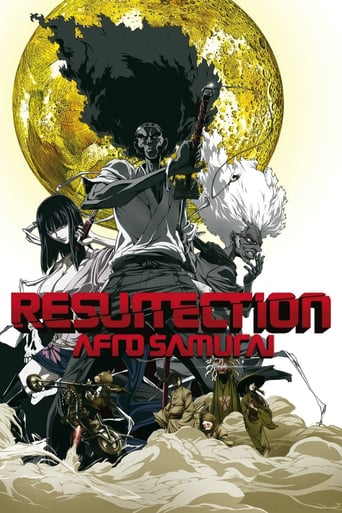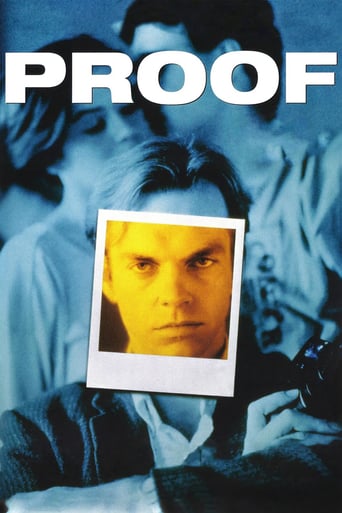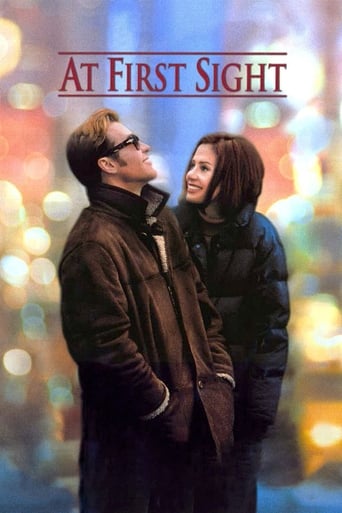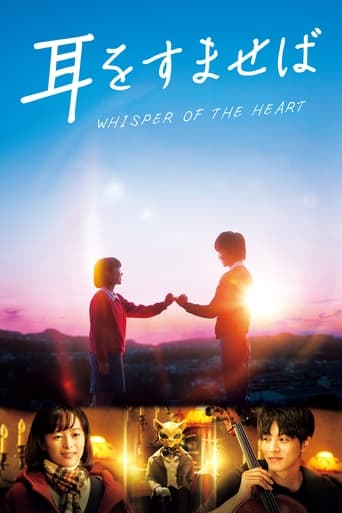Zatoichi: Darkness Is His Ally (1989)
Older, wiser but still a wandering loner, the blind, peace-loving masseur Ichi seeks a peaceful life in a rural village. When he's caught in the middle of a power struggle between two rival Yakuza clans, his reputation as a deadly defender of the innocent is put to the ultimate test in a series of sword-slashing showdowns.
Watch Trailer
Cast


Similar titles
Reviews
I think this is a new genre that they're all sort of working their way through it and haven't got all the kinks worked out yet but it's a genre that works for me.
Very very predictable, including the post credit scene !!!
I love this movie so much
Excellent characters with emotional depth. My wife, daughter and granddaughter all enjoyed it...and me, too! Very good movie! You won't be disappointed.
This 26th also the last of the Zatoichi series indeed is the worst one among the 26 episodes. Shintarô Katsu in 1989 looked fat with natural gray short hairs, he directed and produced this one, added lot of modern stunts, his katana sword's ghost-like flashing cuts now got crimson blood splashed out of his opponents' bodies, unlike the early episodes, only cut but no blood coming out. we got chopped off hands, arms, legs even heads rolling on the ground. we saw him cured the sword in a hotel room. then we saw at the first time he finally got the chance to make love to a beautiful Yakuza local chief in a hot spring.Yeah, these are the new stuff he put into this last episode. but some of the scenes were overly used again and again in former episodes so many times, such as gambling scene, purposely letting two dices littered outside of the cup, cutting fake dices, etc., etc. but the scene that he stumbled into a dirt pit on the road is too much and too lazily copied from one of the earlier episode, simply is not quite good either.One of the worst arrangements of this series is repeatedly used so many same actors played so many different roles in different episodes. although their names or titles might not be the same, but these repeatedly showed actors were just killed by him in last episode, then same actors with the same faces showed up right in the next episode. this careless arrangement had seriously caused some viewing problems. a serious franchised series should not use so many same actors to repeatedly showed in different episodes; it's just stupid and ridiculous.This 26th episode actually should never been made in the first place. it looked just so tiresome and spiritless. by making one like this only meant that Shintarô Katsu just wanted to cash in the last time.Due to this series' popularity at that time, he even put some songs and sang by himself in the last several episodes, but the song in this last one was simply stupid, we got an English song! was it just because he sold this episode to some unknown American TV channel, so he got to put an English roaming samurai song in it for the American TV viewers? Well, the stupidity always amazed me.
I became familiar with the character Zatoichi on IFC's Samurai Saturdays a couple of years ago. When the movies suddenly disappeared from their rotation, it prompted me to sign up for Netflix and see them all, in order.First the character. Zatoichi is a blind "anma" or masseur (common occupation for the blind in that era) that travels the countryside, never stopping for long in one place. Behind this unassuming appearance is a master swordsman, which combined with super human hearing makes him virtually unstoppable (very few throughout the series get the better of him). While technically a "yakuza" (defined sometimes as gangster, sometimes as gambler), Zatoichi is Japan's Lone Ranger, Zorro, Batman or Robin Hood. Considered an outlaw by authorities (often vile characters themselves), he lives by a simple moral code and is generally a folk hero amongst the Edo-period villagers he encounters in his travels.The bulk of the movies (there are 26) follow a pretty basic formula. Zatoichi comes to town, meets and mutually respects a Ronin or Samurai, befriends a sweet young thing or a hooker (with a heart of gold), becomes aware of depredations by the local yakuza boss or government official, gambles, displays his amazing swordsmanship (usually to discourage the boss or official), and is finally pushed too far by boss or official resulting in the wiping out of their underlings and themselves, unhappily fighting aforementioned Samurai or Ronin, and finally leaving the woman crying his name as he wanders off unseen.The formula works well through the first 20 or so movies, then starts getting repetitious as they reuse gags. This happens around the time that TOHO takes over from the defunct DAIEI as the production company. While the production values of these later movies are generally higher, it's offset by more graphic violence and sexual situations. The star of the movies, Shintaro Katsu, co-produced movies 16 through 26 as well as directing numbers 24 and 26. Which brings us to number 26, Zatoichi (1989).There was a gap of 16 years between the last 2 movies and it shows. The character, as is expected, has aged considerably in this period. He's heavier (aren't we all?) and has more grey in his hair. He is still, however, the potent weapon we've come to love over the series. But sadly, it's not, pun intended, executed well.The formula is broadly followed but is muddled with a plodding storyline and too many characters. Perhaps the subtitles aren't giving the proper translations, but characters come and go and their relation to the story and interplay with other characters aren't made clear. A good 20 minutes could be shaved off of this film and would only result in a tightening of the plot. Which is a damn shame, since this his last appearance as Zatoichi and you want to savor every last minute of this film. But sadly I didn't.See the movie for closure. If you're like me you'll be left wanting more (which is how it should be) and wishing for a more fitting end to a franchise that spanned 27 years and lots of great movie moments.Now don't even get me started on Takeshi Kitano's Zatoichi (2003)...
This is to the Zatoichi movies as the "Star Trek" movies were to "Star Trek"--except that in this case every one of the originals was more entertaining and interesting than this big, shiny re-do, and also better made, if substance is more important than surface. Had I never seen them, I would have thought this good-looking but empty; since I had, I thought its style inappropriate and its content insufficient. The idea of reviving the character in a bigger, slicker production must have sounded good, but there was no point in it, other than the hope of making money; it's just a show, which mostly fails to capture the atmosphere of the character's world and wholly fails to take the character anywhere he hasn't been already (also, the actor wasn't at his best). I'd been hoping to see Ichi at a late stage of life, in a story that would see him out gracefully and draw some conclusion from his experience overall; this just rehashes bits and pieces from the other movies, seasoned with more sex and sfx violence. Not the same experience at all.
All hail the genius of Shintaro Katsu for creating such a non-stop movie hero. He will always be Zatoichi in my heart, so it is heartening to know that he finished off his legacy as Zatoichi with a 26th film made thirteen years after he "retired" the character in crippling defeat in 1973. He also co-wrote and directed - his only triple threat in the history of the series. But while the movie is certainly fun, and at times very sweet, it has some flaws that don't quite allow it to live up to the excited originality of its predecessors.The character of Zatoichi is older and wiser, but generally remains as we remember him. The fighting scenes certainly have zing and gore, with buckets of blood pouring whenever someone gets so much as a paper cut (including one particularly horrific blood-soaked scene of a villain continually slicing a subordinate in a drunken fit). And even though it was filmed in the late 80s, Zatoichi #26 doesn't lose any of the series' period-piece charm (in fact, the cinematography and is quite good). Shintaro Katsu is at his most doddering and charming as the now-elderly Zatoichi. He is downright tender and sweet when he entertains a group of children, meets a traveling band of fellow blind masseurs, humbly succumbs to prison torture, uncomfortably accepts gifts from an old friend, or tries to understand the color red. He's fiendishly clever showing up a bunch of gamblers who are more than willing to try and cheat a blind man at dice. And he is even kinda sexy as he enjoys a seductive hot bath with a naked young yakuza powerhouse (Rowr!). It's nice that the film is attentive to the character and he certainly seems more reflective, but the story only truly comes to life when Zatoichi gets down to slicing up some arms, noses, and torsos. Those scenes are unfortunately infrequent, and while the gore is certainly excessive in the most wonderful way, the choreography is sloppy and somewhat uninspired. Katsu was approaching 60 at the time of filming, hardly a young pup, so he can't be faulted too much for toning down the acrobatics - or squatting, as the case may be. The biggest flaw, one that doesn't make the film unwatchable but less likely to enjoy repeated viewings, is that it is overlong by half and bogged down in a plot that...well, just doesn't make any darn sense. Instead of a single foe for Zatoichi to focus on, the film features an abundance of ill-defined villains, a weepy samurai, the previously mentioned sexy yakuza leader, a shifty rival gang-leader, an imprisoned rebel, a young mother with a huge brood of kids, and Katsu's own son in the closest to main villain role as a gambling big-wig. They over-fill the story with sub-plots of battling each other for supremacy, expanding gambling empires, trading antique firearems, and ordering the gradual slaughter of each supporting character - most of whom die at each other's hands rather than by the sword-cane of our blind anti-hero. There's so much extraneous plot that there are long stretches where Ichi himself is pointless, and indeed, it feels like another film were made around him. As a lesser sin, there is a lot to be said against the film's use of a cheesy 80s pop ballad - in English, no less. But it certainly adds the right touch of hilarious cheesiness right after a particularly gory Zatoichi bloodbath (sample lyric: "Looking at life through the eyes of a looooner"). Fortunately, it only pops up in one scene, and the rest of the music is appropriately old school. I'd say this entry into the series is one you should see... oh, maybe fifth. Start with the first film, The Tale of Zatoichi, which is low on actual fighting, fitting more in the tone and style of Kurosawa's style of traditional samurai film. Then go to one of the middle period films - take your pick from the 17 titles currently reissued on DVD by Home Vision Entertainment, they are all fun and ridiculous in their own way (I recommend The Fugitive, but just because I had the chance to see it on the big screen). Then don't miss 1970's Zatoichi Meets Yojimo, a must see thanks to the presence of Toshiro Mifue, and probably the funniest in the series. And finally, jump to Takeshi Kitano's 2003 Zatoichi remake. Kitano's tribute is better than this 1989 entry, and covers many of the same themes.Plus, much better music. THEN watch this one. And after that, you've only got 22 more to go as well as the television series and the ridiculous U.S. remake Blind Fury with Rutger Hauer (an abomination if considered as part of the Zatoichi series, but a hilariously bad stand-alone film) before you have completed the Zatoichi cannon.

